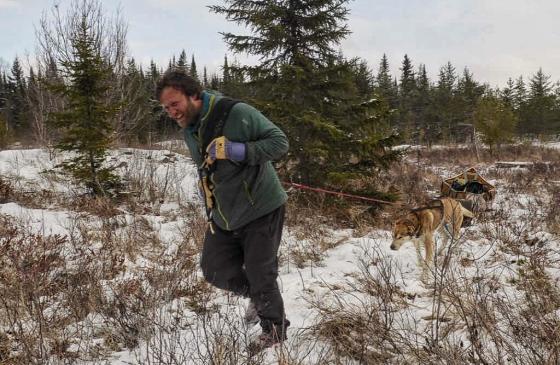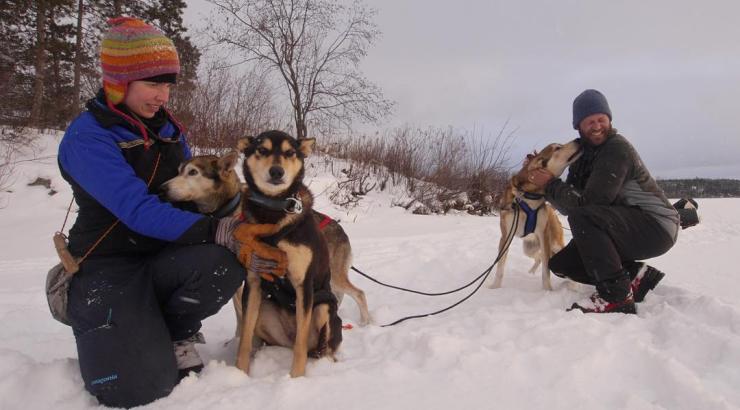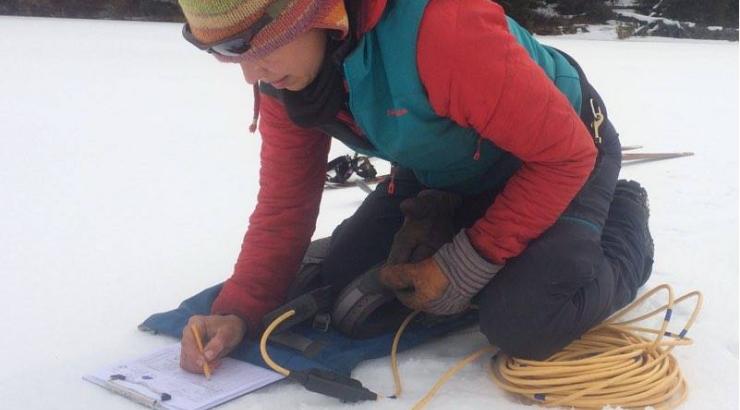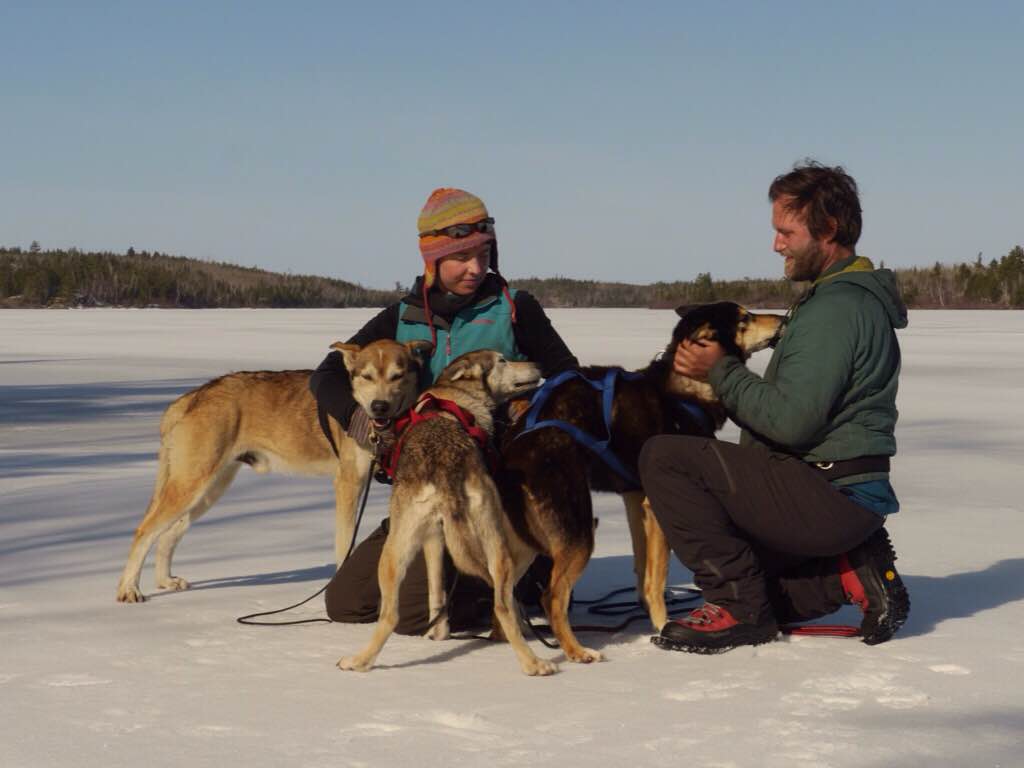 Changes are occurring rapidly out here. The sun is significantly more intense. In December we struggled to charge our batteries on non-cloudy days; now it seems that batteries charge in minutes. That same sun is working to diminish the snow and ice on the lakes. It is melting the snow that covered the ground all winter. A walk in the woods is suddenly made richer by the scent of earth, duff and pine needles– scents we didn't realize we were missing all winter, but now we inhale deeply and relish. The sun heats our tent like a little greenhouse; no fire needed in the wood stove on a sunny day. The length of daylight hours astounds me now– and they're still going to increase! We can travel so much farther in a day than we could back in November, December or January.
Changes are occurring rapidly out here. The sun is significantly more intense. In December we struggled to charge our batteries on non-cloudy days; now it seems that batteries charge in minutes. That same sun is working to diminish the snow and ice on the lakes. It is melting the snow that covered the ground all winter. A walk in the woods is suddenly made richer by the scent of earth, duff and pine needles– scents we didn't realize we were missing all winter, but now we inhale deeply and relish. The sun heats our tent like a little greenhouse; no fire needed in the wood stove on a sunny day. The length of daylight hours astounds me now– and they're still going to increase! We can travel so much farther in a day than we could back in November, December or January.
We have been busy making changes to the gear we have and our mode of transportation. Acorn and Tina have gone home to Frank Moe's kennel in Hovland (near Grand Marais). Tank is settling into his role as the sole dog, sleeping in the tent at night and lounging in the sun by day. When it is time to pull a load, Dave and I are helping Tank pull it, giving us a new appreciation for the hard work the three sled dogs did all winter.
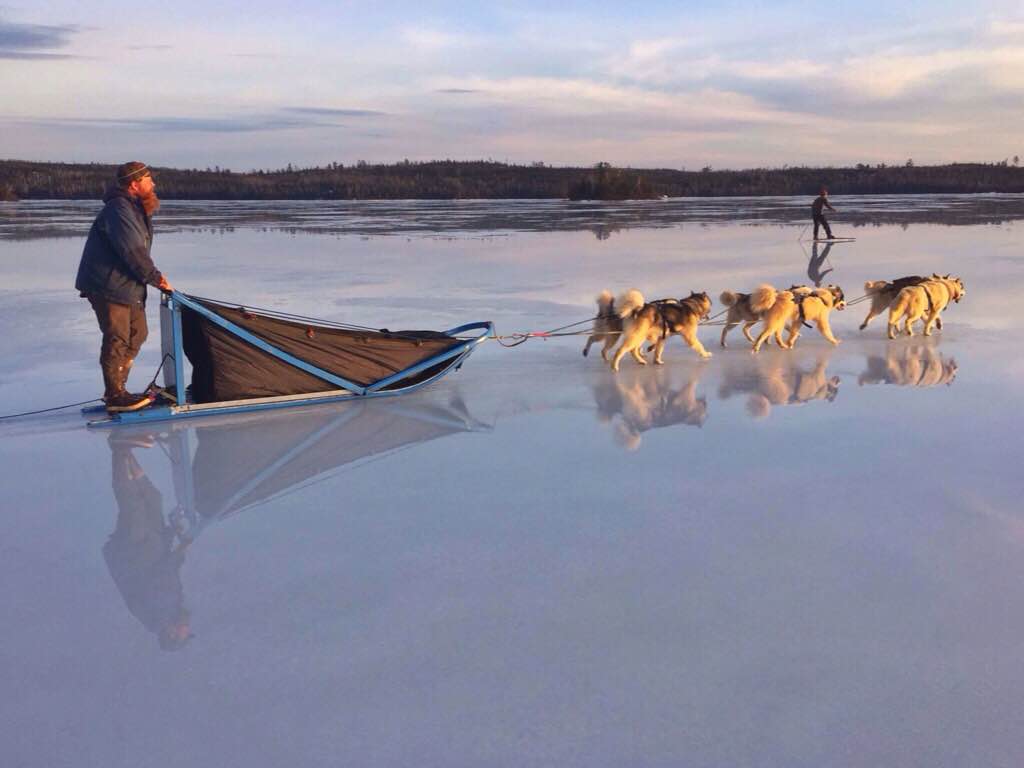 Thanks to the hard work of many volunteers and Wintergreen sled dogs, we have a month's worth of food and all the necessary gear for the paddling season out here with us now. Two separate crews ventured out to supply us with all this stuff.
Thanks to the hard work of many volunteers and Wintergreen sled dogs, we have a month's worth of food and all the necessary gear for the paddling season out here with us now. Two separate crews ventured out to supply us with all this stuff.
First, folks came with a heavily loaded dogsled towed by six burly Canadian Inuit dogs to deliver our human food and dog food on a 60-degree day last week. Then, just yesterday, a crew trekked across Moose and Newfound Lakes with our canoe, drysuits, PFDs and paddles in tow. We were all aware of the irony of their delivery of paddling equipment on a day when the high never surpassed freezing and a heavy snow fell from the sky.
One volunteer, Bobby Shusta, had been there on the day we traded our canoe for toboggans. It seemed only fitting that he would be leading the crew to trade our toboggans for the canoe. We enjoyed visiting with folks, as we were keenly aware that this could be our last human contact for a while. We were also floored by their generosity as they shared all manner of treats with us, from dehydrated sweet potatoes to fresh salad fixings to authentic Minnesota tuna noodle casserole (hotdish).
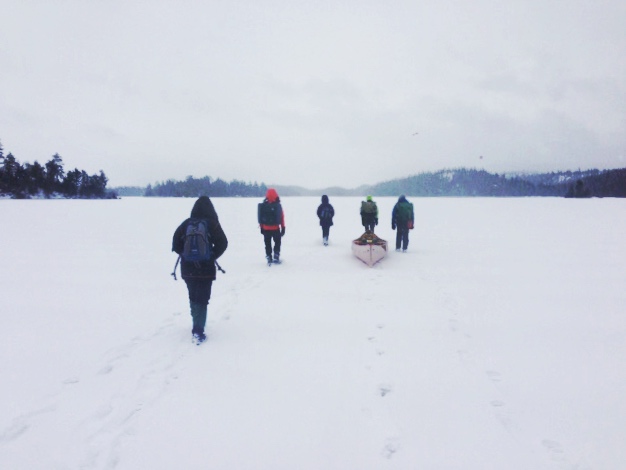 The resupply crew departed with our toboggans, some winter clothing and equipment that we no longer needed while we headed back to camp with everything they had just given us. We had to think creatively about how to travel with a 19-foot Wenonah Itasca Kevlar canoe in these conditions. Optimistic that we could just pull it across the lakes, we set it down on Splash Lake, loaded it and then Dave and Tank labored to move it a few feet. Realizing the grave mistake we had made, we headed back towards Newfound to catch the resupply crew that was now hauling our toboggans toward the Moose Lake landing. We retrieved the longest one, an 11-foot. Black River Sled, and devised a way to strap the canoe securely in place. It looks rather out of place, but it pulls like a dream!
The resupply crew departed with our toboggans, some winter clothing and equipment that we no longer needed while we headed back to camp with everything they had just given us. We had to think creatively about how to travel with a 19-foot Wenonah Itasca Kevlar canoe in these conditions. Optimistic that we could just pull it across the lakes, we set it down on Splash Lake, loaded it and then Dave and Tank labored to move it a few feet. Realizing the grave mistake we had made, we headed back towards Newfound to catch the resupply crew that was now hauling our toboggans toward the Moose Lake landing. We retrieved the longest one, an 11-foot. Black River Sled, and devised a way to strap the canoe securely in place. It looks rather out of place, but it pulls like a dream!
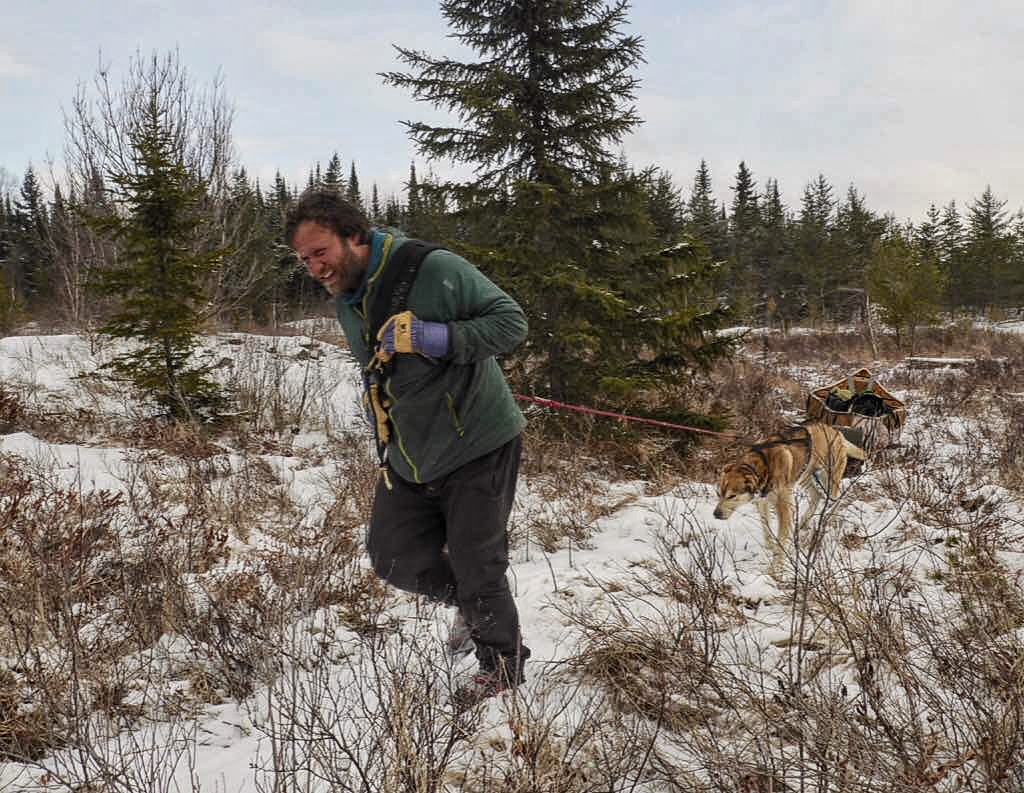 As we returned to camp, we had to disassemble our rig a couple of times to portage over rocky portage trails like we would in the summer, with the canoe and a pack on Dave's shoulders and me carrying a pack with skis attached, paddles in hand, towing the empty toboggan behind me. It was a day for thinking on our feet and jury-rigging. This brought to mind two thoughts. One: this is just the start of creative solutions we will have to come up with as the seasons change. Two: this is one of the main things I love about time spent in the Boundary Waters. While the gorgeous vistas, rugged landscape and silent star-filled nights may be what come to mind first, the challenging moments are what make traveling in the wilderness memorable. There is nothing quite like the sense of accomplishment and confidence built by meeting a challenge in nature head-on and working through it. Some call it character-building. Some talk about type-2 fun (fun when you're laughing and having a good time is type-1 fun; type-2 fun is maybe not so fun while you're experiencing it, but it is what you tell stories about after a trip is over). We experienced plenty of type-2 fun as we trudged 13 miles back to camp, with the east wind blowing fluffy snowflakes in our faces, snow rapidly accumulating on the ground and the sun sinking lower in the sky. Back in the tent, stomachs full of tuna noodle casserole, fresh apples and homemade brownies, we laughed at the absurdity of hauling a loaded canoe through four inches of fresh snow.
As we returned to camp, we had to disassemble our rig a couple of times to portage over rocky portage trails like we would in the summer, with the canoe and a pack on Dave's shoulders and me carrying a pack with skis attached, paddles in hand, towing the empty toboggan behind me. It was a day for thinking on our feet and jury-rigging. This brought to mind two thoughts. One: this is just the start of creative solutions we will have to come up with as the seasons change. Two: this is one of the main things I love about time spent in the Boundary Waters. While the gorgeous vistas, rugged landscape and silent star-filled nights may be what come to mind first, the challenging moments are what make traveling in the wilderness memorable. There is nothing quite like the sense of accomplishment and confidence built by meeting a challenge in nature head-on and working through it. Some call it character-building. Some talk about type-2 fun (fun when you're laughing and having a good time is type-1 fun; type-2 fun is maybe not so fun while you're experiencing it, but it is what you tell stories about after a trip is over). We experienced plenty of type-2 fun as we trudged 13 miles back to camp, with the east wind blowing fluffy snowflakes in our faces, snow rapidly accumulating on the ground and the sun sinking lower in the sky. Back in the tent, stomachs full of tuna noodle casserole, fresh apples and homemade brownies, we laughed at the absurdity of hauling a loaded canoe through four inches of fresh snow.
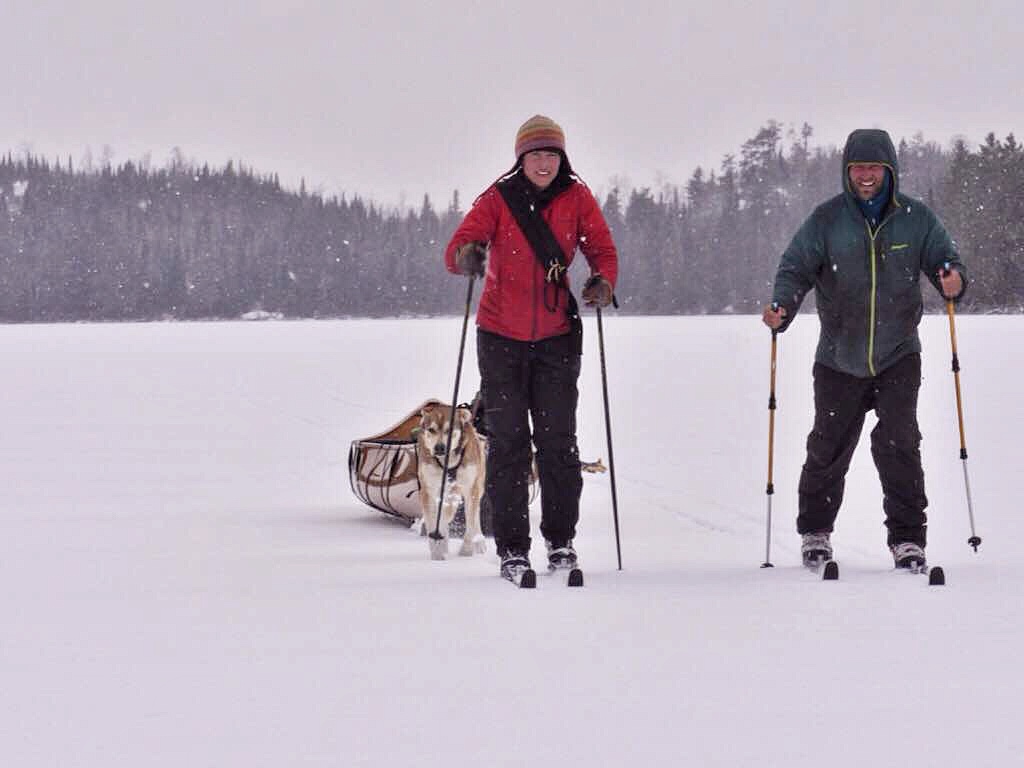 Now we're ready for anything. We have plenty of food and an eclectic assortment of winter and summer equipment. We have a canoe and a toboggan. We have paddles and skis. We have life jackets and down jackets. We're here, in the heart of the Boundary Waters Canoe Area Wilderness, ready and waiting to see what Mother Nature dishes out as winter transitions into spring. It kind of feels like you're at the airport, sitting at the gate, boarding pass and luggage in hand, all ready to go, but you just heard an announcement over the loudspeaker that your flight has been delayed. We're ready to paddle, but honestly we have no way to predict when that day will come– that day when we will ply the surface of the lakes with our paddles instead of plodding across their frozen surfaces.
Now we're ready for anything. We have plenty of food and an eclectic assortment of winter and summer equipment. We have a canoe and a toboggan. We have paddles and skis. We have life jackets and down jackets. We're here, in the heart of the Boundary Waters Canoe Area Wilderness, ready and waiting to see what Mother Nature dishes out as winter transitions into spring. It kind of feels like you're at the airport, sitting at the gate, boarding pass and luggage in hand, all ready to go, but you just heard an announcement over the loudspeaker that your flight has been delayed. We're ready to paddle, but honestly we have no way to predict when that day will come– that day when we will ply the surface of the lakes with our paddles instead of plodding across their frozen surfaces.
[PHOTOS: Dogs towing sled by Willy Vosburgh; Group with canoe by Chris Chandler; all others by Dave and Amy Freeman]
Dave and Amy Freeman, 2014 National Geographic Adventurers of the Year, are dedicated to protecting the Boundary Waters from sulfide-ore copper mining proposed on its wilderness edge. In 2014, they paddled and sailed 101 days and 2,000 miles from Ely, MN, to Washington, DC, on the Paddle to DC. They are now spending a year in the Boundary Waters on A Year in the Wilderness. Follow their journey on social media (#WildernessYear) and by tracking the trip on their map. More A Year in the Wilderness blog posts.
